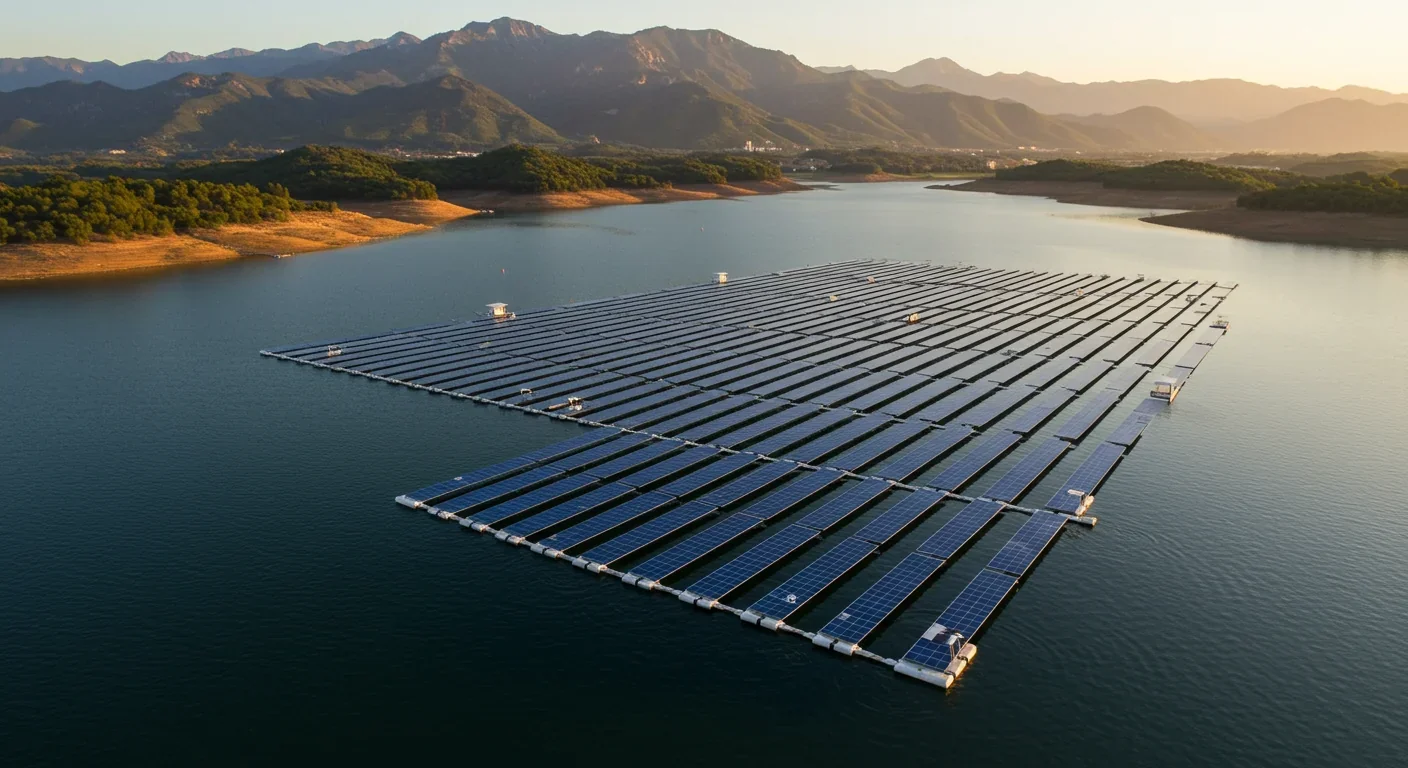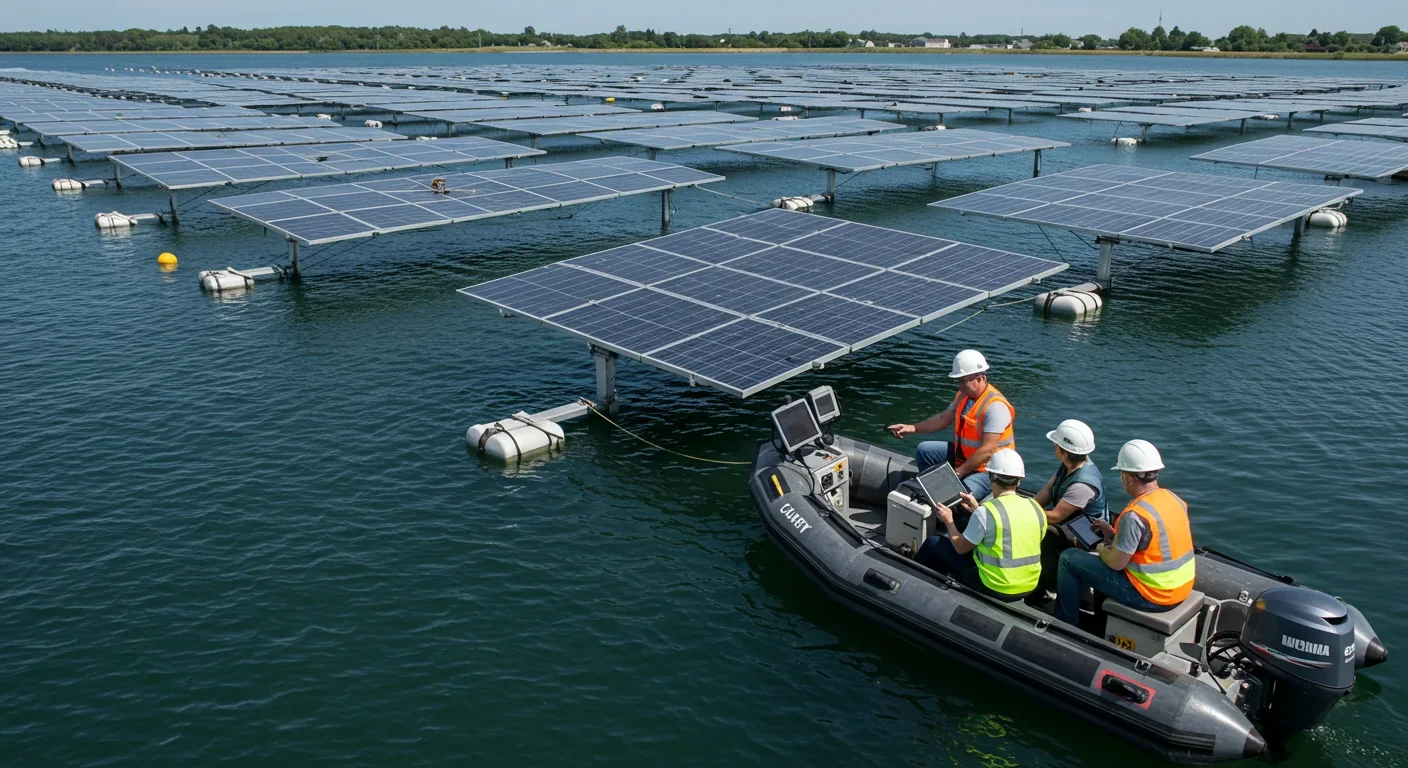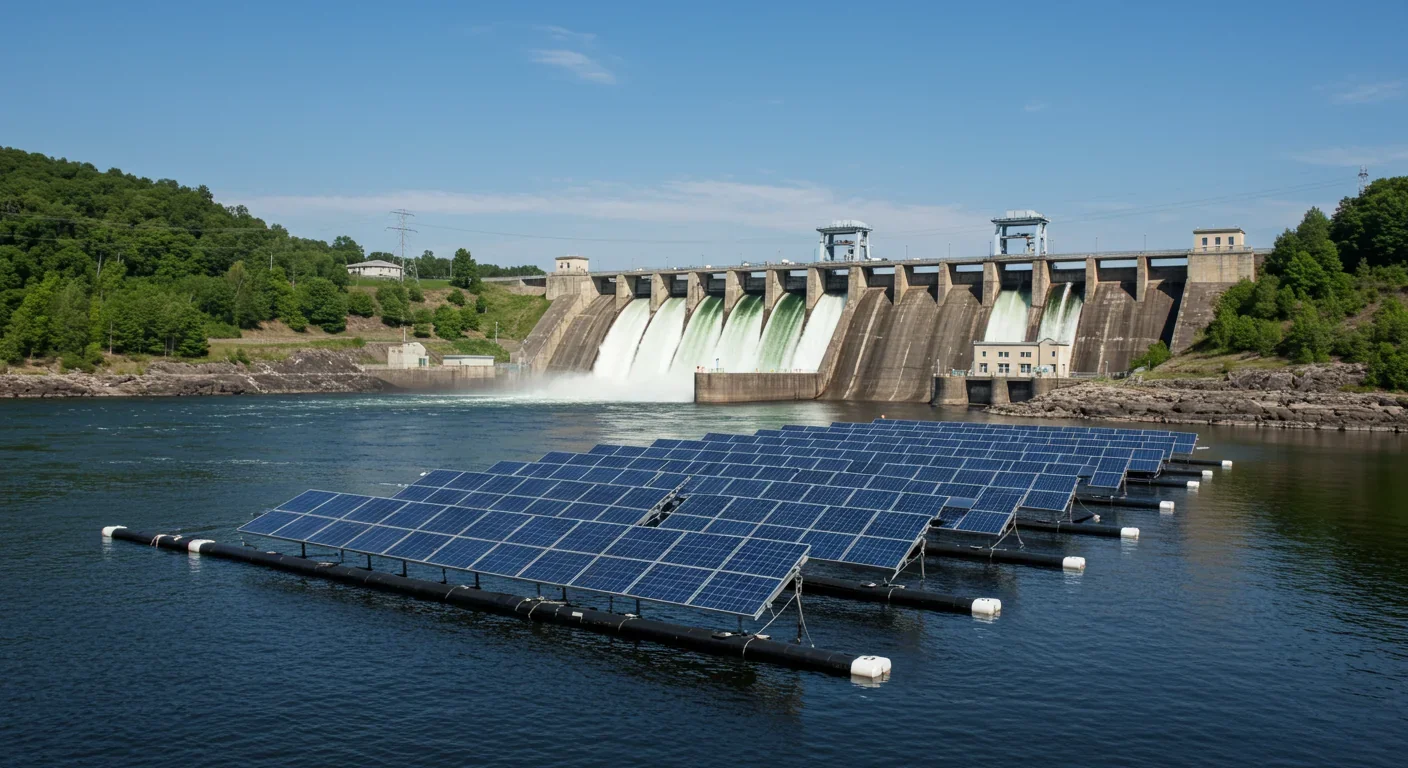Digital Pollution Tax: Can It Save Data Centers?

TL;DR: Floating solar farms are revolutionizing renewable energy by solving two critical problems simultaneously: they reduce water evaporation by up to 70% while generating 5-15% more electricity than land-based panels due to natural cooling. With installations ranging from California's canals to Singapore's reservoirs and South Korea's upcoming 2.1-gigawatt project, this $75 billion market by 2034 offers water-stressed regions a proven technology that preserves farmland, protects aquatic ecosystems, and delivers competitive financial returns despite 10-25% higher installation costs.

What happens when Arizona's critical water reserves evaporate at rates approaching 70% during scorching summers while electricity demand peaks beyond grid capacity? This dual crisis—vanishing freshwater and soaring energy needs—threatens billions globally. Yet floating solar arrays are quietly revolutionizing how humanity tackles both challenges simultaneously, with installations now spanning from California's irrigation canals to Singapore's reservoirs, generating up to 15% more power than land-based systems while slashing evaporation by as much as 70%.
The convergence of water scarcity and renewable energy demands has created an unexpected innovation frontier. Research from Lancaster University reveals that floating photovoltaic (FPV) systems deliver measurable dual benefits: water surface coverage reduces evaporation rates by 50-70% in arid climates while panel cooling from water contact boosts electricity generation by 5-15% compared to traditional ground-mounted arrays.
These aren't theoretical projections. California's Project Nexus, a 1.6-megawatt installation spanning Turlock Irrigation District canals, demonstrates real-world viability. The $20 million pilot proves that elevated solar infrastructure can generate clean electricity while preserving precious water resources. Environmental groups estimate that covering just 27% of suitable U.S. water bodies could produce 10% of national electricity needs while saving tens of billions of gallons annually from evaporation.
The technology addresses what researchers call the water-energy nexus—the interdependence between water security and energy production. As global temperatures rise, both resources become increasingly strained, making integrated solutions essential for human survival.
Floating solar emerged from necessity in land-scarce Japan during the 2000s, where mountainous terrain and dense populations left few options for utility-scale renewables. The 2011 Fukushima disaster accelerated adoption as Japan sought rapid alternatives to nuclear power. Early installations proved that water-based arrays could withstand earthquakes and typhoons while delivering consistent power output.
China transformed this niche technology into industrial scale. The nation's coal mining regions, where abandoned quarries filled with water, became unexpected renewable energy hubs. The 320-megawatt Dezhou Dingzhuang facility, operational since 2023, demonstrates how industrial wastelands can generate clean electricity for hundreds of thousands of homes.
Singapore's journey illustrates another evolution. With less than 1% of land available for solar development, the city-state turned to its reservoirs. The 60-megawatt Tengeh installation, completed in 2021, powers 16,000 homes while reducing carbon emissions by 32 kilotonnes annually. More importantly, it preserves drinking water reserves in a nation that imports most of its freshwater.
These pioneers solved technical challenges that seemed insurmountable: anchoring systems that accommodate water level fluctuations, corrosion-resistant materials for harsh marine environments, and electrical systems that safely operate above water. Their solutions created a playbook for global deployment.
Floating solar arrays employ specialized engineering that goes far beyond simply placing panels on water. The foundation consists of high-density polyethylene (HDPE) floats, designed to support photovoltaic modules while maintaining buoyancy across decades of operation. These platforms interconnect through flexible couplings that allow independent movement, preventing stress fractures during waves or storms.
Anchoring presents unique challenges. Unlike land installations with concrete foundations, floating arrays require dynamic mooring systems. Engineers deploy three primary methods: bottom anchoring using concrete blocks for deep reservoirs, bank anchoring with tensioned cables for shallow water bodies, and hybrid systems combining both approaches. Advanced installations like Portugal's Alqueva Dam incorporate GPS-guided positioning systems that adjust for seasonal water level variations exceeding 30 meters.
The cooling mechanism that boosts efficiency operates through convective heat transfer. Water beneath panels maintains temperatures 8-15°C lower than ambient air during peak sunlight. This temperature differential prevents the performance degradation that plagues desert installations, where panels can reach 70°C. Studies from Northern Cyprus demonstrate that optimal configurations—panels tilted at 6° facing north—maximize both cooling benefits and energy yield.
Electrical infrastructure requires marine-grade components. Inverters housed on floating platforms or shoreline stations convert DC power to grid-compatible AC. Submarine cables, similar to offshore wind farms, transmit electricity to land-based substations. Singapore's Tengeh facility pioneered drone-based monitoring systems that reduce maintenance costs by 30% while ensuring continuous operation.

The global floating solar revolution accelerates with installations that would have seemed impossible a decade ago. India's 100-megawatt Telangana project, fully operational since 2023, showcases integration with existing hydroelectric infrastructure. During monsoons, hydropower dominates; in dry seasons, floating solar compensates for reduced turbine output. This complementary relationship solves renewable energy's intermittency challenge.
Texas embarks on an ambitious 500-megawatt floating solar initiative across state reservoirs. Third Pillar Solar's partnership with local water authorities promises to conserve 15% of freshwater currently lost to evaporation—critical for a state experiencing unprecedented droughts. The economic model proves compelling: water savings alone justify the additional 10-25% installation costs compared to ground-mounted systems.
South Korea's Saemangeum project, scheduled for 2025 completion, will become the world's largest at 2.1 gigawatts. Built on a tidal flat converted to freshwater reservoir, it demonstrates how engineered water bodies can serve dual purposes. The installation will power 1 million homes while preventing saltwater intrusion that threatens agricultural regions.
Thailand's approach differs strategically. The government mandates floating solar on all hydroelectric reservoirs exceeding 100 megawatts capacity. The Sirindhorn Dam installation reduced evaporation by 500 million cubic meters in its first operational years—water that now generates additional hydropower during critical dry periods. The project achieved payback in just five years, half the typical timeline for renewable investments.
Floating solar delivers ecological advantages that extend beyond water conservation and clean energy. Shade from panels reduces surface temperatures by 2-3°C, disrupting conditions that trigger toxic algal blooms. In California's Central Valley, where agricultural runoff creates perfect conditions for cyanobacteria, covered canals show 60% reduction in algae growth. This improvement protects both human health and irrigation infrastructure.
Aquatic ecosystems respond in unexpected ways. Singapore's Tengeh Reservoir witnessed otter populations double from seven to fourteen after installation, as floating platforms created shelter and hunting grounds. Fish congregate beneath arrays, finding refuge from predators and extreme temperatures. Marine biologists report 50% higher species diversity around well-designed installations compared to open water.
The technology aids climate adaptation for vulnerable water bodies. Lancaster University research using advanced modeling shows that floating solar could mitigate harmful lake stratification—temperature layering that depletes oxygen and kills aquatic life. Arrays covering 10-40% of surface area maintain healthy circulation patterns while preserving photosynthesis zones.
Carbon footprint analyses reveal additional benefits. Manufacturing floating platforms requires less concrete and steel than ground-mounted systems with equivalent capacity. The preserved land remains available for agriculture, forests, or development—critical in regions facing competing land-use pressures. Lifecycle assessments show 20% lower emissions compared to traditional solar farms when land-use changes are included.
Extreme weather poses the greatest threat to floating solar infrastructure. Hurricane-force winds generate waves that stress anchoring systems through millions of flexing cycles. Ciel & Terre, a leading manufacturer, developed wave attenuators—floating barriers that absorb energy before it reaches solar arrays. Their Hydrelio platform survived Typhoon Yagi and Hurricane Milton in 2024 without production losses, while nearby ground-mounted systems suffered extensive damage.
Corrosion accelerates in marine environments. Salt spray degrades conventional solar equipment within years. Engineers responded with specialized coatings, marine-grade aluminum frames, and sealed junction boxes rated for continuous water exposure. Advanced installations use sacrificial anodes, similar to ship hulls, that corrode preferentially to protect critical components.
Electrical safety requires rigorous protocols. Water and electricity create inherent risks, especially during maintenance. Modern systems incorporate multiple safeguards: ground-fault interruption that cuts power within milliseconds of leakage detection, elevated inverter platforms above maximum flood levels, and specialized training for technicians who perform repairs from boats.
Winter ice formation challenges installations in temperate climates. Expanding ice exerts tremendous pressure on floating structures, potentially crushing platforms. Swiss engineers at Lac des Toules developed flexible coupling systems that accommodate ice movement while maintaining electrical connections. Their high-altitude installation operates successfully despite six months of annual ice cover.
Maintenance logistics differ fundamentally from land-based systems. Technicians access panels via boats or floating walkways, adding complexity and cost. However, water moisture naturally cleans panels, reducing dust accumulation that plagues desert installations. Automated cleaning robots, deployed at Singapore facilities, further minimize manual intervention.
The financial equation for floating solar has shifted dramatically. While installation costs run 10-25% higher than ground-mounted systems—approximately $1.23 per watt versus $0.95—operational advantages often compensate. The 5-15% efficiency gain from water cooling translates directly to revenue. In hot climates, this benefit alone justifies the premium.
Water savings provide quantifiable value. California's Department of Water Resources calculates that prevented evaporation from a 10-megawatt floating array equals $500,000 annually in water replacement costs. For drought-stricken regions, this represents critical resource preservation beyond monetary value. Insurance companies increasingly factor water conservation into renewable energy project assessments.
Land opportunity costs tip scales further. Prime agricultural land in California's Central Valley leases for $1,000-3,000 per acre annually. A 100-megawatt solar farm typically requires 400-600 acres—representing $400,000-1,800,000 in annual lease costs or foregone agricultural revenue. Floating installations eliminate this expense while preserving food production capacity.
Government incentives accelerate adoption. The U.S. Inflation Reduction Act provides 30% investment tax credits for floating solar, with additional bonuses for projects in energy communities. Singapore offers feed-in tariffs 20% higher for floating installations compared to rooftop solar. China provides low-interest loans specifically for water-based renewable projects.
Financial modeling by investment banks shows 12-15% internal rates of return for well-sited floating solar projects—comparable to conventional solar despite higher capital requirements. The dual revenue stream from electricity generation and water conservation creates resilient business models attractive to institutional investors.
Asia dominates with 81% of global floating solar capacity, but other continents race to catch up. Brazil targets 100 gigawatts of floating solar on hydroelectric reservoirs by 2030. The Sobradinho Dam project alone will add 2.5 gigawatts, preventing evaporation losses that could power São Paulo for months. Integration with existing transmission infrastructure reduces deployment costs by 40%.
Africa embraces floating solar to address acute water-energy challenges. Ghana's Bui Dam installation preserves water for 30,000 hectares of irrigation while generating electricity for rural communities. Kenya explores floating solar on Lake Victoria, where evaporation claims 3 billion cubic meters annually. Preliminary studies suggest 10% coverage could power 2 million homes while saving enough water for 5 million people.
Europe advances with 70-megawatt annual additions. The Netherlands leads with 303 megawatts operational, utilizing former sand quarries and recreational lakes. Portugal's expansion of Alqueva to 75 megawatts total creates Europe's largest installation. France mandates floating solar assessment for all new reservoir construction, recognizing dual benefits for water-stressed Mediterranean regions.
Middle Eastern nations view floating solar as critical for economic diversification. The United Arab Emirates plans 2.4 gigawatts on coastal waters and artificial lakes by 2030. Saudi Arabia evaluates Red Sea installations that could desalinate seawater using generated electricity—solving water and energy challenges simultaneously.
Australia investigates floating solar for mining operations. Remote sites often lack grid connections and rely on diesel generators. Floating arrays on tailings ponds could provide clean power while preventing toxic dust emissions. Early installations show 30% cost savings compared to trucked fuel.

The transition demands new expertise. Maritime engineers, previously focused on offshore oil or shipping, now design solar mooring systems. Electricians require specialized training for over-water operations. Universities establish dedicated programs combining renewable energy, marine engineering, and environmental science.
Communities near suitable water bodies face choices. Supporting floating solar brings construction jobs, ongoing maintenance employment, and potential revenue sharing from energy sales. However, recreational use may be restricted, and visual impacts concern some residents. Successful projects engage stakeholders early, addressing concerns through careful siting and benefit-sharing agreements.
Policymakers must update regulations written for land-based development. Water rights, environmental permits, and grid connection rules require modification. Progressive jurisdictions streamline approvals for floating solar, recognizing urgency of climate and water challenges. The proposed POWER our Reservoirs Act would authorize federal projects across U.S. Bureau of Reclamation facilities.
Investment opportunities proliferate as the market expands. Analysts project the floating solar sector reaching $75 billion by 2034, growing at 27% annually. Manufacturing companies specializing in floating platforms, anchoring systems, and marine-grade electrical components see surging demand. Project developers with expertise navigating water permits command premium valuations.
The technology roadmap includes innovations that could dramatically expand deployment. Offshore floating solar, currently limited to protected bays, may extend to open ocean with improved storm resistance. Hybrid systems combining floating solar with offshore wind share infrastructure costs. Advanced materials could reduce prices to parity with land-based systems within five years.
As water becomes scarcer and energy demand soars, floating solar transitions from novelty to necessity. Nations that master this technology secure competitive advantages in resource management, energy independence, and climate adaptation. The question isn't whether floating solar will transform global infrastructure, but how quickly humanity can scale this solution to meet existential challenges. The convergence of proven technology, economic viability, and urgent need creates conditions for exponential growth that could reshape civilization's relationship with both water and energy.

Recent breakthroughs in fusion technology—including 351,000-gauss magnetic fields, AI-driven plasma diagnostics, and net energy gain at the National Ignition Facility—are transforming fusion propulsion from science fiction to engineering frontier. Scientists now have a realistic pathway to accelerate spacecraft to 10% of light speed, enabling a 43-year journey to Alpha Centauri. While challenges remain in miniaturization, neutron management, and sustained operation, the physics barriers have ...

Epigenetic clocks measure DNA methylation patterns to calculate biological age, which predicts disease risk up to 30 years before symptoms appear. Landmark studies show that accelerated epigenetic aging forecasts cardiovascular disease, diabetes, and neurodegeneration with remarkable accuracy. Lifestyle interventions—Mediterranean diet, structured exercise, quality sleep, stress management—can measurably reverse biological aging, reducing epigenetic age by 1-2 years within months. Commercial ...

Data centers consumed 415 terawatt-hours of electricity in 2024 and will nearly double that by 2030, driven by AI's insatiable energy appetite. Despite tech giants' renewable pledges, actual emissions are up to 662% higher than reported due to accounting loopholes. A digital pollution tax—similar to Europe's carbon border tariff—could finally force the industry to invest in efficiency technologies like liquid cooling, waste heat recovery, and time-matched renewable power, transforming volunta...

Humans are hardwired to see invisible agents—gods, ghosts, conspiracies—thanks to the Hyperactive Agency Detection Device (HADD), an evolutionary survival mechanism that favored false alarms over fatal misses. This cognitive bias, rooted in brain regions like the temporoparietal junction and medial prefrontal cortex, generates religious beliefs, animistic worldviews, and conspiracy theories across all cultures. Understanding HADD doesn't eliminate belief, but it helps us recognize when our pa...

The bombardier beetle has perfected a chemical defense system that human engineers are still trying to replicate: a two-chamber micro-combustion engine that mixes hydroquinone and hydrogen peroxide to create explosive 100°C sprays at up to 500 pulses per second, aimed with 270-degree precision. This tiny insect's biochemical marvel is inspiring revolutionary technologies in aerospace propulsion, pharmaceutical delivery, and fire suppression. By 2030, beetle-inspired systems could position sat...

The U.S. faces a catastrophic care worker shortage driven by poverty-level wages, overwhelming burnout, and systemic undervaluation. With 99% of nursing homes hiring and 9.7 million openings projected by 2034, the crisis threatens patient safety, family stability, and economic productivity. Evidence-based solutions—wage reforms, streamlined training, technology integration, and policy enforcement—exist and work, but require sustained political will and cultural recognition that caregiving is ...

Every major AI model was trained on copyrighted text scraped without permission, triggering billion-dollar lawsuits and forcing a reckoning between innovation and creator rights. The future depends on finding balance between transformative AI development and fair compensation for the people whose work fuels it.